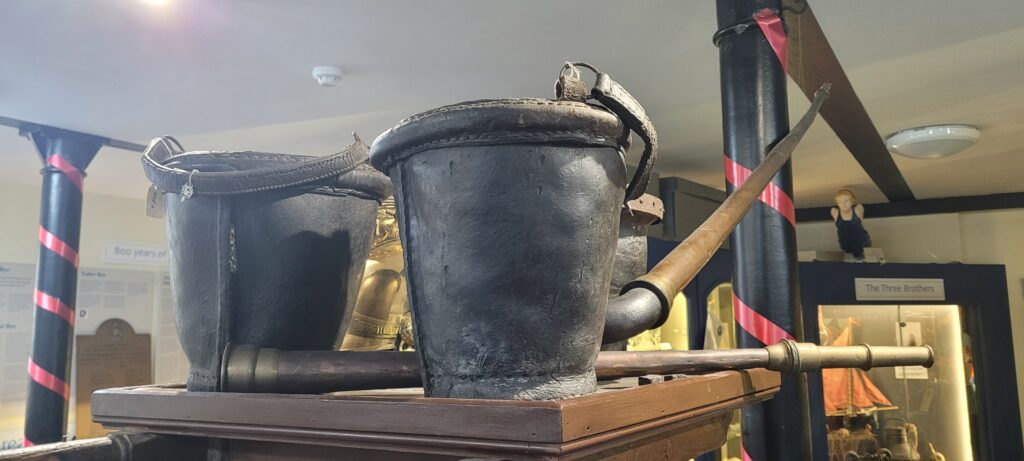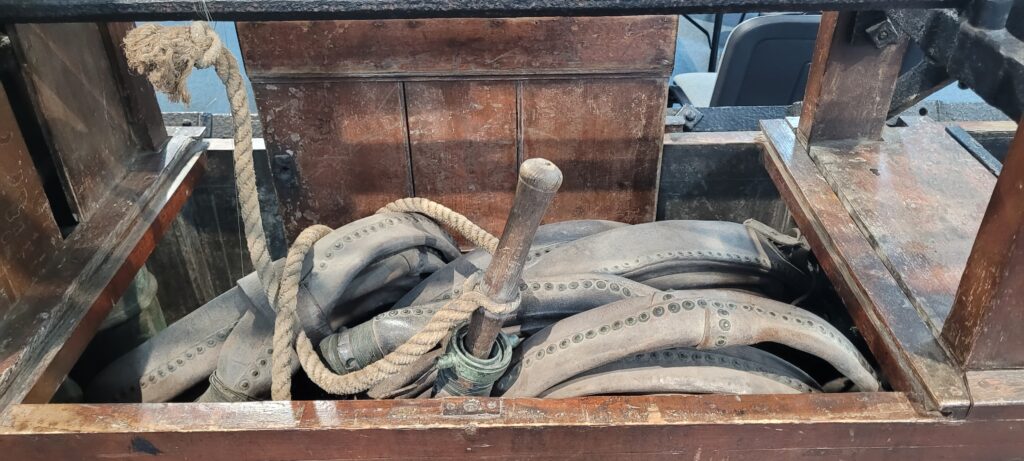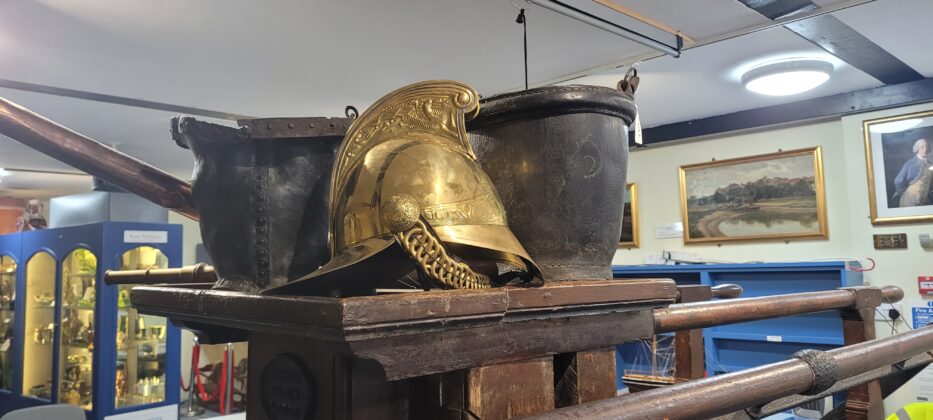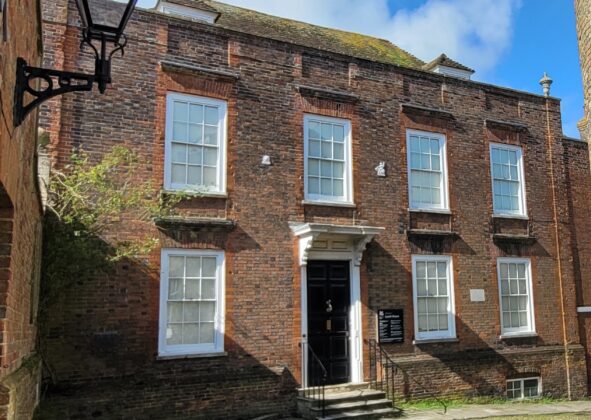The 18th century fire engine used by Rye’s volunteer fire brigade
“My favourite article in East Street is the wooden 18th century fire engine. It is very prominent near the entrance and there is an old photograph of it, with its crew. The museum has an authentic Rye fireman’s helmet and a replica helmet that can be handled. An inquisitive young visitor asked how the fire engine worked. I tried to explain but then searched Google and found a fabulous YouTube video of a re-enactment. A QR code is now on the fire engine, which links to the video and that brings the whole thing to life! I’m so pleased to see the reaction of visitors when they use the link. Often because I have encouraged them to do so.” Museum director and volunteer, Geoffrey Austen.
In Tudor times fire was a major hazard when towns and cities were crowded with wooden buildings and many houses were roofed with thatch. Thatched roofs were such a fire risk that they were banned in London in 1212. Much later in Rye, in 1561, any thatched roof that was taken down was not allowed to be replaced again with thatch and, in 1564, thatchers were prohibited from laying any thatch within the town walls and 200 feet from the walls. Fines were issued for those ignoring these orders.
At that time, another fire risk was the use of wooden chimneys and firing of chimneys resulted in fines for householders. In 1578, 22 wooden chimneys were recorded including in the Strand, outside the Landgate, in a lane of Watchbell Street, in Church Square, and their owners fined. One, owned by John Potten’s widow, “was very dangerous and the house is thatched”. In 1580, 31 owners were fined for 40 wooden chimneys. Brick chimneys were expensive but gradually the wooden ones were replaced by brick – by 1586 only five people were fined for seven wooden chimneys.
Up until the mid-17th century, fires were fought using buckets, hooks to pull down thatch or whole buildings to create firebreaks, and handheld pumps. However, it took the Great Fire of London of 1666 for fire fighting to become more organised. The fire, which spread rapidly from the baker’s shop in Pudding Lane, destroyed 13,200 homes, 89 churches and the original St Paul’s Cathedral and left tens of thousands homeless.
After the Great Fire, insurance companies were set up and insured houses were given a fire mark or badge, with the company emblem or design, to fix on the outside of the building to identify which company insured which property. Each insurance company set up their own fire brigade with its own uniform, who would look for the company fire mark before putting out the fire. Early companies included the Fire Office, the Friendly Society, the Hand in Hand (which later became the Commercial Union) and the Sun Fire Office.

Fire marks for the London Insurance Company (Sun Fire Insurance company) can be seen on the outside of Lamb House in West Street and an unusual fire mark can also be seen on the outside of the former house of Radclyffe Hall on the high street.
These early fire brigades were equipped with leather buckets, ladders, axes and hand pumps but in 1672 the Dutch artist, Jan Van der Heyden, invented a flexible leather hose. A horse-drawn improved fire engine was made in 1721 by Richard Newsham, which made firefighting much more effective.

In 1723 the Borough of Rye decided to buy “two of the new fire engines” which were likely to be one made by Richard Newsham, of Bray in Berkshire who produced and patented an improved engine and soon dominated the fire engine market in England. Pulled as a cart to the fire, these manual pumps were manned by teams of four to 12 men and could deliver up to 120 gallons per minute pumped in a continuous stream instead of in spurts. It could spray up to 40 metres so could reach most roofs.
The Rye Castle Museum fire engine is attributed to Brahm and Son, London and is dated between 1807 and 1816. However, this model does not match those of Brahm at the time and it is likely to be a Newsham that was sent to Brahm in London to be refurbished after a century fighting fires in Rye. It was then returned to Rye to continue firefighting.

During the 18th and 19th centuries volunteer fire brigades were formed in many towns and cities. Rye Borough Fire Brigade was formed in the 1860s and occupied part of the town hall until 1937. Volunteers’ houses were linked to a battery-charged electric alarm in 1894. If a fire started “the first alarm…must be given at WF Clark’s, Ivy Cottage…next the town hall, which is in electric communication with all members of the brigade”.

Initially pulled by hand, the later town fire engine was pulled by two horses who were kept at the stables in Tower Street at Messrs Wright and Pankhurst Furniture Removers, where the driver worked. On receiving the alarm, the driver and the horses rushed to the town hall where the engine was kept nearby.
Notable fires that were attended by the fire brigade was a major fire in 1898 of the offices of Vidlers in the Strand, which also threatened the nearby Old Strand Brewery. In 1907 the mineral water factory on the Strand, WE Colebrooke’s caught fire. It contained tubes of carbonic acid to aerate the water and glass bottles which caused a loud explosion. The windmill by the river Tillingham was burnt down in 1930 and was so close to the gasworks across the railway that the manager of the gasworks at the time, Francis Rook, climbed to the top of the gasholder ready with a pick to pierce the tank and let the gas escape in order to avoid a massive explosion. In 1960 the Central Garage in Cinque Ports Street drew crowds to watch the fire being fought, as many did in 2019 when the George suffered its major fire.
With the threat of war looming, the Fire Brigades Act 1938 required that local authorities set up their own brigades and a government minister, the secretary of state for home affairs was given responsibility for the fire service. The Auxiliary Fire Service was made up of volunteers who were trained and worked alongside the permanent fire fighters. The old fire station in Ferry Road (now Ellis Bros funeral directors) was opened in 1937 by EF Benson, who was mayor at the time.
Wartime bombing, particularly of incendiary bombs, meant that the local services had difficulties dealing with the conditions and so in 1941 the fire service was nationalised. In 1948 the fire services were given back to the control of the county and borough councils. In 1997 the East Sussex County Council Fire Brigade became the East Sussex Fire and Rescue Service managed by the East Sussex Fire Authority.
The fire service, made up of full and part-time fire fighters, and in its many guises, has played a vital part in the community life of Rye with several generations of some families being involved. Longtime Ryers will remember, with pride, their contribution to keeping the town safe both in the past and today.
Image Credits: Juliet Duff/ Rye Castle Museum , Juliet Duff , Rye Castle Museum , Kevin Hale / Geograph.org.uk https://commons.wikimedia.org/wiki/File:Rye_old_fire_station_-_geograph.org.uk_-_1632012.jpg CC BY-SA 2.0 https://creativecommons.org/licenses/by-sa/2.0/.









interesting article. When I saw the picture I recalled that when the Rye embroiders’ were asked to make a picture depicting the history of Rye now displayed in the Rye Castle Museum. I was asked to do the fire engine. I was given the postcard picture to do it from…Small— then I was told it had to be smaller than the post card size! so felt I knew every detail of the engine after I had finished.
Its rather a splendid picture. Some of the needlework is beautifully done…
Shame that the museum does not have information who designed the picture and the names of those who contributed the separate pieces of work.
I agree that it would be nice to have more information about the splendid work of art which is much admired by many of the visitors to The Ypres Tower. I will make some enquiries to see what information I can discover. Judith, if you have any additional information, or perhaps anecdotes from the creation of the embroidery, please do contact me via the museum office.
You never know, if we can gather sufficient information we might be able to have a follow up article in Rye News.